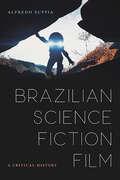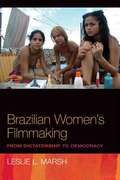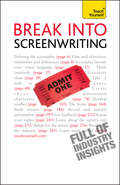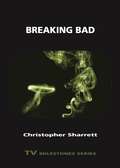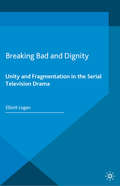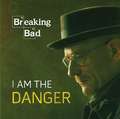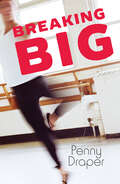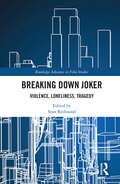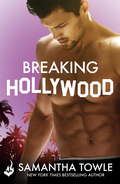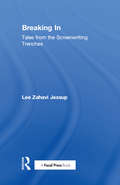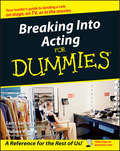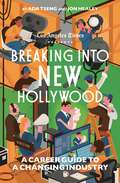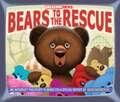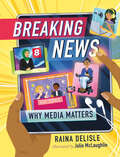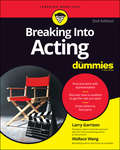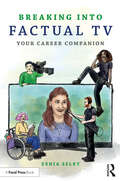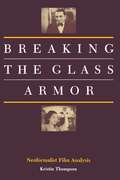- Table View
- List View
Brazilian Science Fiction Film: A Critical History (SUNY series in Latin American Cinema)
by Alredo SuppiaThis book offers a pioneering critical history of Brazilian science fiction (SF) cinema, from its first appearances in the mid-twentieth century to the present. Though frequently overlooked by scholars, SF cinema from the Global South has reinvigorated the genre in recent decades. In this comprehensive study—the first of its kind in either English or Portuguese—Alfredo Suppia draws out the unique features and universal resonance of SF film in Brazil, a country that has fittingly been called "the land of the future." In Suppia's analysis, Brazilian SF stems from and responds to a long history of inequality in which everyday reality has often resembled a movie-like dystopia. Analyzing both short and feature films in the context of social, political, and economic transformations, Suppia rethinks SF film in general from a southern perspective.
Brazilian Women's Filmmaking: From Dictatorship to Democracy
by Leslie MarshAt most recent count, there are no fewer than forty-five women in Brazil directing or codirecting feature-length fiction or documentary films. In the early 1990s, women filmmakers in Brazil were credited for being at the forefront of the rebirth of filmmaking, or retomada, after the abolition of the state film agency and subsequent standstill of film production. Despite their numbers and success, films by Brazilian women directors are generally absent from discussions of Latin American film and published scholarly works. Filling this void, Brazilian Women's Filmmaking focuses on women's film production in Brazil from the mid-1970s to the current era. Leslie L. Marsh explains how women's filmmaking contributed to the reformulation of sexual, cultural, and political citizenship during Brazil's fight for the return and expansion of civil rights during the 1970s and 1980s and the recent questioning of the quality of democracy in the 1990s and 2000s. She interprets key films by Ana Carolina and Tizuka Yamasaki, documentaries with social themes, and independent videos supported by archival research and extensive interviews with Brazilian women filmmakers. Despite changes in production contexts, recent Brazilian women's films have furthered feminist debates regarding citizenship while raising concerns about the quality of the emergent democracy. Brazilian Women's Filmmaking offers a unique view of how women's audiovisual production has intersected with the reconfigurations of gender and female sexuality put forth by the women's movements in Brazil and continuing demands for greater social, cultural, and political inclusion.
Break Into Screenwriting: Your complete guide to writing for stage, screen or radio
by Ray FrenshamThis is a comprehensive, jargon-free guide for all budding screenwriters. Its aim is not just to guide you through the techniques and skills you need to write for the screen (film and television), but also to give you guidance on how to approach the industry as a whole. Focusing on every aspect of screenwriting, from how to set about the writing process to how to develop your characters, plot and structure, this book will give you all the guidance you need to break into this highly competitive industry and make a career for yourself as a screenwriter.NOT GOT MUCH TIME?One, five and ten-minute introductions to key principles to get you started.AUTHOR INSIGHTSLots of instant help with common problems and quick tips for success, based on the author's many years of experience.TEST YOURSELFTests in the book and online to keep track of your progress.EXTEND YOUR KNOWLEDGEExtra online articles at www.teachyourself.com to give you a richer understanding of screenwriting.FIVE THINGS TO REMEMBERQuick refreshers to help you remember the key facts.TRY THISInnovative exercises illustrate what you've learnt and how to use it.
Break Into Screenwriting: Your complete guide to writing for stage, screen or radio
by Ray FrenshamThis is a comprehensive, jargon-free guide for all budding screenwriters. Its aim is not just to guide you through the techniques and skills you need to write for the screen (film and television), but also to give you guidance on how to approach the industry as a whole. Focusing on every aspect of screenwriting, from how to set about the writing process to how to develop your characters, plot and structure, this book will give you all the guidance you need to break into this highly competitive industry and make a career for yourself as a screenwriter.
Break into Screenwriting: Your complete guide to writing for stage, screen or radio (TY Creative Writing)
by Ray FrenshamThis is a comprehensive, jargon-free guide for all budding screenwriters. Its aim is not just to guide you through the techniques and skills you need to write for the screen (film and television), but also to give you guidance on how to approach the industry as a whole. Focusing on every aspect of screenwriting, from how to set about the writing process to how to develop your characters, plot and structure, this book will give you all the guidance you need to break into this highly competitive industry and make a career for yourself as a screenwriter.NOT GOT MUCH TIME?One, five and ten-minute introductions to key principles to get you started.AUTHOR INSIGHTSLots of instant help with common problems and quick tips for success, based on the author's many years of experience.TEST YOURSELFTests in the book and online to keep track of your progress.EXTEND YOUR KNOWLEDGEExtra online articles at www.teachyourself.com to give you a richer understanding of screenwriting.FIVE THINGS TO REMEMBERQuick refreshers to help you remember the key facts.TRY THISInnovative exercises illustrate what you've learnt and how to use it.
Breakfast with Sharks: A Screenwriter's Guide to Getting the Meeting, Nailing the Pitch, Signing the Deal, and Navigating the Murky Waters of Hollywood
by Michael LentWhat They Didn't Teach You in Your Screenwriting Course. Screenwriters, listen up! Breakfast with Sharks is not a book about the craft of screenwriting. This is a book about the business of managing your screenwriting career, from advice on choosing an agent to tips on juggling three deal-making breakfasts a day. Prescriptive and useful, Breakfast with Sharks is a real guide to navigating the murky waters of the Hollywood system. Unlike most of the screenwriting books available, here's one that tells you what to do after you've finished your surefire-hit screenplay. Written from the perspective of Michael Lent, an in-the-trenches working screenwriter in Hollywood, this is a real-world look into the script-to-screen business as it is practiced today. Breakfast with Sharks is filled with useful advice on everything from the ins and outs of moving to Los Angeles to understanding terms like "spec," "option," and "assignment. " Here you'll learn what to expect from agents and managers and who does what in the studio hierarchy. And most important, Breakfast with Sharks will help you nail your pitch so the studio exec can't say no. Rounded out with a Q&A section and resource lists of script competitions, film festivals, trade associations, industry publications, and more, Breakfast with Sharks is chock-full of "take this and use it right now" information for screenwriters at any stage of their careers. From the Trade Paperback edition.
Breaking Bad (TV Milestones Series)
by Christopher SharrettBreaking Bad (2008–2013), a remarkable synthesis of the crime film, the sitcom, the western, and the family melodrama, is a foundational example of new television in the early twenty-first century. Receiving multiple Emmy Awards, it launched the careers of its creators and stars, most notably Bryan Cranston as high school teacher turned drug manufacturer Walter White, whose attempt to grab the American dream results in the destruction of family, home, community, and himself. In this book, Christopher Sharrett examines the innovations of Breaking Bad through a study of its main character, using psychoanalysis, genre study, gender studies, American studies, and the graphic arts to assist an exploration of the supreme danger of modern, postindustrial toxic masculinity embodied in Walter White. Serving as a fresh start for the American Movie Classics (AMC) cable outlet, Breaking Bad is probably the most uncompromised rendering of the white American male’s rage in early twenty-first-century fiction. Set against a deindustrialized American landscape, its conflicted morality can seem less ambiguous than repugnant when we note the use of humor throughout, particularly as characters are introduced and killed off. Walter’s relationships with his son, who has cerebral palsy, his former student turned business partner, his long-suffering wife, and his DEA brother-in-law are layered on top of the show’s reflection of the very real challenges facing America today, which are not limited to the opioid epidemic, lax gun laws, and racial violence. Some critics have accused Breaking Bad of inciting a disturbance rather than criticizing, as it relies heavily on the audience’s humor. Sharrett’s argument for why the show is the canniest dramatic insight of our times is worth the price of admission for scholars and students of media studies and superfans alike.
Breaking Bad and Dignity: Unity and Fragmentation in the Serial Television Drama (Palgrave Close Readings in Film and Television)
by Elliott LoganAn ambitious interpretation of the critically celebrated and widely popular crime drama Breaking Bad , this book argues that not only should the series be understood as a show that revolves around the dramatic stakes of dignity, but that to do so reveals - in new ways - central aspects of serial television drama as an art form.
Breaking Bad: I am the Danger
by Running Press<P> Warning: Contents Exremely Volatile <P> This officially-licensed companion to the hit series features the most volatile and exciting moments from episodes from all five seasons. With full-color photographs and memorable quotes from Walt, Jesse, Skylar, Hank, Gus, Mike, Saul, Tuco, and the rest of the unforgettable cast, Breaking Bad: I Am the Danger follows the evolution of Walter White from high school chemistry teacher and mild-mannered family man to Heisenberg, Albuquerque's most dangerous kingpin of the drug trade.
Breaking Big (Orca Limelights)
by Penny DraperWill his big break kill his career before it even starts Robin’s got everything it takes to be a principal dancer: the body, the feet, the strength and the passion. But his devil-may-care attitude plays havoc with discipline at the Premier Dance School. One more prank may be one too many. That’s why everyone is shocked when he’s the only student dancer picked to understudy with the company, even though the choice makes sense—Robin is cast as Puck, the annoying trickster fairy in A Midsummer’s Night Dream. Shock turns to horror when the principal dancer is injured and Robin has to perform instead. The other dancers don’t think he can pull it off, and even Robin wonders if it’s too much too soon. This short novel is a high-interest, low-reading level book for middle-grade readers who are building reading skills, want a quick read or say they don’t like to read! The epub edition of this title is fully accessible.
Breaking Down Joker: Violence, Loneliness, Tragedy (Routledge Advances in Film Studies)
by Sean RedmondBreaking Down Joker offers a compelling, multi-disciplinary examination of a landmark film and media event that was simultaneously both celebrated and derided, and which arrived at a time of unprecedented social malaise. The collection breaks down Joker to explore its aesthetic and ideological representations within the social and cultural context in which it was released. An international team of authors explore Joker’s sightlines and subtexts, the affective relationships, corrosive ideologies and damning if ambivalent messages of this film. The chapters address such themes as white masculinity, identity and perversion, social class and mobility, urban loneliness, movement and music, and questions of reception and activism. With contributions from scholars from screen studies, theatre and performance studies, psychology and psychoanalysis, geography, cultural studies and sociology, this fully interdisciplinary collection offers a uniquely multiple operational cross-examination of this pivotal film text, and will be of great importance to scholars, students and researchers in these areas.
Breaking Hollywood: A sexy, laugh-out-loud romance
by Samantha TowleBreaking Hollywood is a hot and hilarious standalone romance from New York Times bestselling author Samantha Towle...It wasn't supposed to be like this... I wasn't supposed to be boyfriendless, homeless and jobless at twenty-eight. And I most definitely wasn't supposed to hit Hollywood's resident bad boy Gabriel Evans with my car and break his foot. Now I'm stuck in his apartment, taking care of him while he's incapacitated. Living with the hottest guy in Hollywood, who I've had a crush on forever, doesn't sound like a chore, right? Wrong. Gabriel Evans is rude, crude, drinks way too much and, as soon as his foot is healed, I'm out of here. So, why do I keep forgetting to check the classifieds? And keep getting flustered when I see him shirtless? Breaking Hollywood wasn't part of the plan. But neither was falling in love with him.'Breaking Hollywood is romantic comedy at its best. It's laugh-out-loud funny, incredibly sexy, sweetly heartfelt and unadulterated fun... You'll be smitten with everything about this entertaining, steamy and feel-good romance' USA Today's Happy Ever AfterLoved Breaking Hollywood? Check out Samantha's sexy, laugh-out-loud romance, Wardrobe Malfunction, out now!
Breaking In: Tales from the Screenwriting Trenches
by Lee JessupBreaking In: Tales from the Screenwriting Trenches is a no-nonsense, boots-on-the-ground exploration of how writers REALLY go from emerging to professional in today’s highly saturated and competitive screenwriting space. With a focus on writers who have gotten representation and broken into the TV or feature film space after the critical 2008 WGA strike and financial market collapse, the reader will learn from tangible examples of how success was achieved via hard work and specific methodology. This book includes interviews from writers who wrote major studio releases (The Boy Next Door), staffed on television shows (American Crime, NCIS New Orleans, Sleepy Hollow), sold specs and television shows, placed in competitions, and were accepted to prestigious network and studio writing programs. These interviews are presented as Screenwriter Spotlights throughout the book and are supported by insight from top-selling agents and managers (including those who have sold scripts and pilots, had their writers named to prestigious lists such as The Black List and The Hit List) as well as working industry executives. Together, these anecdotes, learnings and perceptions, tied in with the author's extensive experience in and knowledge of the industry, will inform the reader about how the industry REALLY works, what it expects from both working and emerging writers, as well as what next steps the writer should engage in, in order to move their screenwriting career forward.
Breaking Into Acting For Dummies
by Wallace Wang Larry GarrisonProvides the expert advice you need to get your big break!Jump-start your career and land that paying partFrom preparing for auditions to finding an agent, the acting business is a challenging and competitive field. This indispensable guide is what every aspiring actor needs to get a foot in the door. Discover how to market yourself, choose a dynamic head shot, create a stellar acting resume, join unions, and pay the bills while you pursue your acting dreams.The Dummies Way* Explanations in plain English* "Get in, get out" information* Icons and other navigational aids* Tear-out cheat sheet* Top ten lists* A dash of humor and fun
Breaking Into New Hollywood: A Career Guide to a Changing Industry
by The Los Angeles TimesA Simon & Schuster eBook. Simon & Schuster has a great book for every reader.
Breaking News: Alien Alert (Breaking News #3)
by David BiedrzyckiBears in space! The bears from Breaking News: Bear Alert and Bears to the Rescue are back, and this time they're extraterrestrial.When a UFO beams up Baby Bear and abducts the family, the human world goes crazy. Hilarity and chaos ensue as scouts, scientists, street vendors, and the mayor try to put their own spin on the story. Intrepid but bumbling reporter Chad Newsworthy covers it all, searching for the truth: Why did aliens snatch up these animals? (Hint: It's someone special's birthday!)
Breaking News: Bear Alert (Breaking News #1)
by David BiedrzyckiWe interrupt your day for this breaking news. . .Two bears awaken from hibernation and go to town—literally. During their visit, they eat at a diner, dress up at a department store, and stop a couple of bank robbers, all the while mistaking the townspeople&’s terror for friendliness. The news-reporting-style of storytelling puts readers in the action and on the edge of their seats. Illustrations jam-packed with puns, clues, and jokes will have the whole family or classroom laughing out loud and eager to find out what happens next—will the bears terrorize the town? Will the cat burglars be caught? Will the city come to a grinding halt?Tune in to find out.We now return you to your regularly scheduled day.
Breaking News: Bears to the Rescue (Breaking News #2)
by David BiedrzyckiA missing cub, a carnival, and a gang of cat burglars… Hold on to your hats! Best-selling author David Biedrzycki brings back the hilarious bears from Breaking News: Bear Alert, but now they have sleepy bear cub in tow. When the cub goes missing Mama and Papa Bear go on the hunt. Their search takes them to the town carnival where the whole family rides the Ferris wheel, rocks the rollercoaster, and inadvertently foils another dastardly plot by the persistent cat burglars from Bear Alert. Covering the story is intrepid—but bumbling—reporter Chad Newsworthy and the rest of the crew at Channel 3 News.
Breaking News: Why Media Matters (Orca Think #10)
by Raina DelisleKey Selling Points Kids are spending more time on the internet and social media, where they may be exposed to fake news, clickbait, misinformation and disinformation. It's important for them to learn how to become critical news consumers. The media industry is at a critical juncture. After years of being battered by the internet and social media, new business models are starting to emerge. But much damage has been done and trust in the media has dropped to an all-time low. Breaking News is full of tips on how kids can get involved in the media industry and share their thoughts, including writing letters to the editor, taking journalism classes, joining the school paper, getting a paper route and even starting their own media outlet. The book includes stories from journalists, including kids, that will inspire readers to get involved in the industry. The author is an award-winning journalist who worked for daily newspapers, TV news programs and independent online publications across Canada.
Breaking Pointe
by Chenée MarrapodiAmelia loves ballet more than anything, but the sudden arrival of an intense new teacher shifts the Academy focus from classical to contemporary dance. Amelia is out of her depth with the edgy choreography and unsettled by its world-ending theme, especially when a shock diagnosis really might bring her life crashing down.Valentina is completely at home with the new style but has troubles off the dance floor. As she desperately strives to secure a scholarship and save her dance career, money problems and an unexpected romance have her in a complete spin.With so much at breaking point, the girls will need to decide what really matters before everything falls apart.
Breaking into Acting For Dummies (For Dummies Ser.)
by Wallace Wang Larry GarrisonUnderstand the business side of your showbiz career We all know acting can be a glittering whirl of glamour—plush red carpets, simply divine outfits, huge sums of money, and oh, the parties! But what a lot of wannabe actors forget is that it takes a lot of practical work to get to the flashbulbs of your first premiere, and that the savviest actors put as much stress on the business side of the profession as they do on the show. Breaking Into Acting For Dummies demystifies the behind-the-curtain side of showbiz to help you understand how it really works, who the decision-makers are, what they’re looking for when they’re picking talent, and how to get them on your side. If you truly want to be the next Emma Stone or Leonardo DiCaprio, you’ll want to have a well-thumbed copy of this book alongside your pile of scripts. Written by two friendly insiders, this guide takes you behind the scenes to help you map out your plan of attack, showing you how to open doors—and keep them open—and use your time wisely, so you’re not breaking a leg rushing from one random audition to another. You’ll understand how to flesh out your professional persona as thoroughly as a movie part, craft your resume as minutely as a script, and judge the angle of your headshots and webcam appearances as intimately as any director. Once you’ve mastered these skills, it’s time to go to market as your own publicity department, building your media and online presence until everyone who’s anyone knows exactly who you are. Understand different acting markets—from theater to commercials Network in-person and online Build your image via resumes, head shots, and webcam Keep a firm grip on the financial side Whether you’re studying, a hopeful amateur, or have been treading the boards for a while, this is your breakthrough script for succeeding in the business of acting, and for learning how to play your ultimate role: yourself.
Breaking into Factual TV: Your Career Companion
by Zenia SelbySuccessfully entering the TV industry can be difficult to navigate. Breaking into Factual TV will guide you through the process from how to get your first job to how to make it at the top. Written in a clear and accessible way, author Zenia Selby demystifies the TV industry for new entrants and covers all the key roles including runner, researcher, assistant producer, producer and director. Selby reveals what no one ever tells you when you start working at a TV production company – the chain of hierarchy, the most effective ways to network, and the best way to structure your work. The book will travel with you up your career ladder: as you progress from runner to researcher to producer to director, each section provides you with the blueprint you need to excel with every promotion and warns you of the pitfalls to avoid. Perspectives from industry professionals are provided throughout, with interviews with Mitchell Langcaster-James (The Only Way is Essex, QI, and Celebs Go Dating), Jeremy Turner (Edward Snowden: Whistleblower or Spy?, and Women in Prison), Alec Lindsell (Inside the Factory, and The One Show), and Sophie Smith (Albert: The Power Behind Victoria, and Digging for Britain) to offer insight into the reality of their roles. The book is ideal for emerging professionals and graduates of television courses looking to take their first step in the TV industry.
Breaking the Glass Armor
by Kristin Thompson"Classical works have for us become covered with the glassy armor of familiarity," wrote Victor Shklovsky in 1914. Here Kristin Thompson "defamiliarizes" the reader with eleven different films. Developing the technique formulated in her Eisenstein's Ivan the Terrible (Princeton, 1981), she clearly demonstrates the flexibility of the neoformalist approach. She argues that critics often use cut-and-dried methods and choose films that easily fit those methods. Neoformalism, on the other hand, encourages the critic to deal with each film differently and to modify his or her analytical assumptions continually. Thompson's analyses are thus refreshingly varied and revealing, ranging from an ordinary Hollywood film, Terror by Night, to such masterpieces as Late Spring and Lancelot du Lac. She proposes a formal historical way of dealing with realism, using Bicycle Thieves and The Rules of the Game as examples. Stage Fright and Laura provide cases in which the classical cinema defamiliarizes its own conventions by playing with audience expectations. Other chapters deal with Tati's Les Vacances de Monsieur Hulot and Play Time and Godard's Tout va bien and Sauve qui peut (la vie). Although neoformalist analysis is a rigorous, distinctive approach, it avoids extensive specialized vocabulary and esoteric concepts: the essays here can be read separately by those interested in the individual films. The book's overall purpose, however, goes beyond making these particular films more accessible and intriguing to propose new ways of looking at cinema as a whole.
Breakout
by Kevin EmersonWhen Anthony's angst-ridden rock 'n' roll lyrics go viral, he's unwittingly cast as the school rebel. The truth is, he's not trying to be anyone's hero. Anthony Castillo needs a new life. His teachers are clueless autocrats except for Mr. Darren, who's in charge of the rock band program. The girls at school are either shallow cutebots or out of his league. And his parents mean well, but they just make things worse. It's as if Anthony is stuck on the bottom level of his favorite video game, Liberation Force 4.5. Except there is no secret escape tunnel and definitely no cheat code. Fed up, pissed off, and feeling trapped, Anthony writes his first song for his rock band, the Rusty Soles. His only problem: Arts Night. If he exercises his right to free speech and sings his original lyrics--where his own bombs will drop--he and his band will be through. The clock is ticking. Time for Anthony to pick his battles and decide what's really worth fighting for.
Breaks in the Air: The Birth of Rap Radio in New York City
by John KlaessIn Breaks in the Air John Klaess tells the story of rap’s emergence on New York City’s airwaves by examining how artists and broadcasters adapted hip hop’s performance culture to radio. Initially, artists and DJs brought their live practice to radio by buying time on low-bandwidth community stations and building new communities around their shows. Later, stations owned by New York’s African American elite, such as WBLS, reluctantly began airing rap even as they pursued a sound rooted in respectability, urban sophistication, and polish. At the same time, large commercial stations like WRKS programmed rap once it became clear that the music attracted a demographic that was valuable to advertisers. Moving between intimate portraits of single radio shows and broader examinations of the legal, financial, cultural, and political forces that indelibly shaped the sound of rap radio, Klaess shows how early rap radio provides a lens through which to better understand the development of rap music as well as the intertwined histories of sounds, institutions, communities, and legal formations that converged in the post-Civil Rights era.
